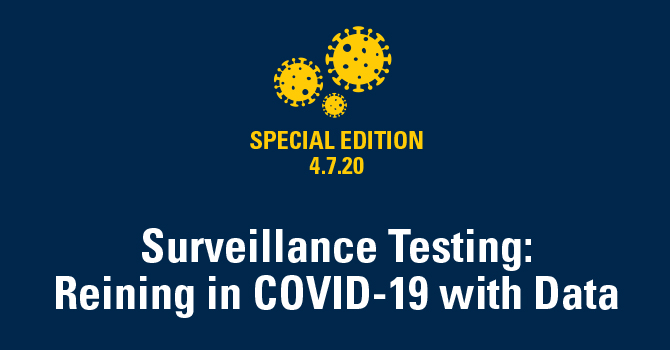Surveillance Testing: Reining in COVID-19 with Data

The need for diagnostic testing has been a critical issue throughout the spread of the coronavirus epidemic. But another form of testing may be the key to gaining control over the pandemic. Surveillance testing currently being performed throughout the world is how we gather the data that tells health officials where, who, and how populations are being affected, and that information can then be used to get in front of further spread. We’ll talk to epidemiologist Emily Martin about how it works and who’s doing it right.
Listen to "Surveillance Testing: Reining in COVID-19 with Data 4.7.20" on Spreaker.
|
Subscribe and listen to Population Healthy on Apple Podcasts, Spotify, Google Podcasts, iHeartRadio, YouTube or wherever you listen to podcasts! Be sure to follow us at @umichsph on Twitter, Instagram, and Facebook, so you can share your perspectives on the issues we discussed, learn more from Michigan Public Health experts, and share episodes of the podcast with your friends on social media. |
Speaker 1: Right now, public health professionals and researchers around the globe are gathering samples of COVID-19, the disease caused by coronavirus. There is a vital need to understand more precisely how we could stop this disease to help us limit future infections. We've heard a lot about testing people with symptoms and the challenges to testing, and the next steps will rely significantly on expanded testing.
Hello and welcome to Population Healthy, a podcast from the University of Michigan School of Public Health. This episode is part of a series of special additions of our podcast, focusing on the ongoing coronavirus pandemic. Emily Martin is an Associate Professor of Epidemiology at the University of Michigan School of Public Health, and an expert in viral respiratory illnesses. We talked with her about surveillance testing, what that means and why it matters.
Martin: Surveillance testing as a priority is second to clinical care. So the initial days of an outbreak in the initial days as a virus moves into an area, for any virus, the testing will oftentimes be centralized at the health department, and the goal is to define when the virus is here. Once that's established, then testing is very much about supporting clinical care in making sure that the patients that are most severe getting taken care of. Once that's under control then we move into this surveillance phase where we try to both continue taking care of people who need clinical care, but then defining the epidemic as it rises and falls to be able to inform public health. And so that's a system that kind of comes into play as the acute situation gets under control.
The purpose of surveillance tests is to monitor the current state of the epidemic and the best way to think about this is how it's currently used for influenza. So the CDC will send reports out that say influenza season has started, it's very high, it's very severe this year, or it’s starting to end. And they can also use this data to figure out how useful our tools are. How useful is the vaccine, how useful are antivirals, in an urgent situation. So those same systems can be deployed to monitor COVID infections in the same way. And so we can use those to monitor is it moving into new areas? Is it affecting some groups of people more than other groups of people? Is it going up, is it going down?
What surveillance doesn't mean and I think it's an important point to keep in mind is surveillance doesn't mean that everybody gets tested. Surveillance means that we test the right samples of the population, in a way that allows us to make inferences as efficiently as possible. It doesn't mean that we test everybody. We have to strike this balance between getting the information we need, leaving enough tests around to prioritize them for clinical care and then being able to couple that information together to be able to do this without testing the whole population.
Speaker 1: As we hear on the news each day that more and more people are getting tested and testing positive, it's hard to not feel anxious. But Martin says often those high numbers mean we're actually making progress.
Martin: Case cuts are very useful in the early days of an epidemic because case counts give us that sense of is the virus here or not, yes, or no? And which populations are we seeing the virus in at all? As testing ramps up, it's natural to see case counts just explode. We're gonna see case counts that rise and rise and rise and rise and it doesn't mean that the virus is spreading faster and faster. What it means is that we're doing a better job of testing and capturing and we're learning more about the size of the epidemic. And so case counts in this phase of an epidemic, they can be quite frightening, but really it means that we're learning more and not that the situation on the ground is substantially changing. It takes some caution to be able to watch those numbers rise and rise and remember that our personal level of risk hasn't actually changed a whole lot from week to week.
As we get surveillance systems in place, case counts get converted to incidents where we start talking about the number of people per 100,000 that get infected. If you think about the comparison with the way influenza is monitored, you usually hear about influenza in a sort of rate or prevalence sort of sense. So one out of 10 people will be infected this year or something like that. And so, case counts will morph into that type of thinking.
You may hear people now speculating about numbers. I've heard numbers anywhere from 20% 40% 60% of people will eventually be infected by the time all of this is said and done. Right now, it's important to remember that when you're in what we call the exponential phase of an epidemic, when an epidemic is growing and growing and growing, it hasn't started to turn a corner yet, it is very, very difficult to estimate that number. We don't know if the corner is turning a week from now, a month from now, we don't know how high it will be when we start to turn the corner. And so people are making their best guess possible because they wanna be as prepared as possible for the worst case scenario, so that hospitals already and we have the supplies on hand but there's just a lot of speculation that goes into deriving those numbers.
Speaker 1: There's one place we can look to as sort of a best case scenario, and that’s South Korea - a prime example of the impact of quick and effective surveillance testing.
Martin: They're testing a ton of people in South Korea, and those tests are being used to identify who needs to isolate carefully to not infect other people. There's a couple of key differences between us and South Korea. So the US is a bit larger than South Korea. There are a lot more people and we are spread out a lot further geographically than South Korea is. The other thing is that our infrastructure is spread out and that our public health infrastructure is not as dense, and as easily activated in one local area as happens in South Korea. Because once you find a positive test what you need to do is a lot of communication with the health department to find out who the contacts are and to try to spread people out so they don't infect each other. It's very resource intensive for a country as large as the United States. So what South Korea has done is amazing and I think it's a model and it's a goal that people should look to, but it's a challenge to implement that in other settings.
Speaker 1: The US has been slower to respond to coronavirus than South Korea, and interventions like physical distancing that require buy-in from Americans are critical to slowing the spread of the virus.
Martin: If you are initiating a response and trying to get people's attention and people aren't really paying attention cause they don't think it's a big deal and it feels like you're overreacting, that usually means in public health that you're doing the right thing at the right time. If you wait until it's a critical need, then public health style interventions, so interventions that aren't vaccines or new drugs or things like that, the kind of things that we have control just in our day-to-day life with, those are the things that have to be applied before it's obviously a big deal.
Speaker 1: This has been a special edition of Population Healthy, a podcast from the University of Michigan School of Public Health. During the ongoing coronavirus pandemic, we’ll work to bring you analysis from our community of experts to help you understand what this public health crisis means for you. To stay up-to-date in between special edition episodes, be sure to check out our website publichealth.umich.edu, subscribe to our Population Healthy newsletter at publichealth.umich.edu/news/newsletter and follow us on Twitter, Instagram, and Facebook @umichsph.
In This Episode
 Emily Martin
Emily Martin
Associate Professor of Epidemiology at the University of Michigan School of Public Health
Emily Martin is an Associate Professor of Epidemiology at the University of Michigan School of Public Health. Her research focuses on respiratory virus epidemiology, hospital epidemiology, infection prevention, and molecular epidemiology. She also leads the Martin Lab, a team of researchers at the School of Public Health whose objectives include the use of molecular epidemiology to characterize the spread and persistence of viral infections and the evaluation of vaccination to reduce the burden of respiratory infections. Learn more.
